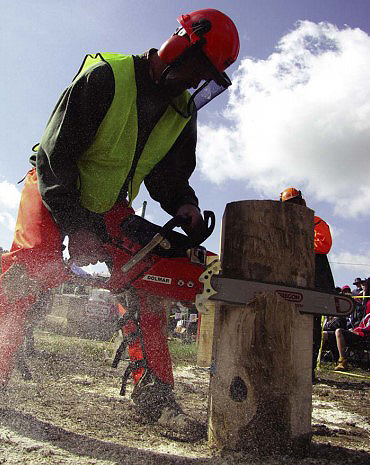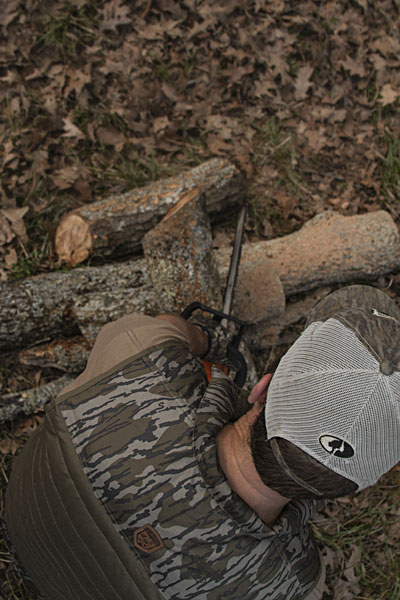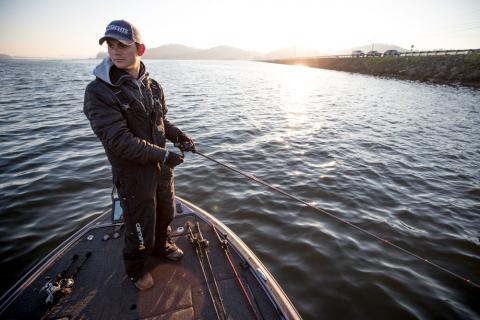Scott Bestul | Originally published in GameKeepers: Farming for Wildlife Magazine. To subscribe, click here.

I was just trying to create a habitat, but I could have easily killed myself. Two hundred yards from the back of my house is a little copse of junk trees—scrubby box elder, a smattering of aspen, some ash and maple that would never amount to much—that my neighbor and I had agreed to clear-cut. So on a cold winter day, I grabbed a chainsaw, a handful of tools, and went to work. I felled about a dozen trees without incident then went to work clearing some brush around the next tree I wanted to drop.
They call them “accidents” because they’re unforeseen. They usually happen fast, and often they’re just plain stupid. One second my saw was zipping through saplings, the next it was glancing off something (a rock? a frozen stump?) and headed right for my upper shin. I guess I saw this in time to check the arc of the bar as it neared my leg. Or maybe I just got lucky. All I know is, when I got the saw away from my body I saw a ragged cut in my pants leg, which I fully expected to start filling with blood any second. It never did, and when I got home later, I learned that the saw had torn through my Carhartt’s, chewed through my first set of longjohns, and stopped after it nicked the second set.
But for that minute I stood frozen in fear. Sure, I was only 200 yards from my house, but could I have covered that distance on one leg had the saw bit into the other? My wife and kids were gone for the day, and even if I dialed 911 on my cell phone, I live in a rural area; most first responders feel good if they can reach a house like mine in 10 minutes. I’ve shot enough deer to know it doesn’t take that long for something to bleed out. And even if the wound wasn’t fatal, what if I couldn’t walk at all? Temperatures were in the single digits that winter day, and hypothermia would have been as a large a concern as the wound.
I’m clearly not the “sharpest broadhead in the quiver,” but I was smart enough to know all that saved me that day from serious trouble—or worse—was luck.
Weekend Warriors
Luck isn’t enough for me when it comes to a serious tool like a chainsaw, and it shouldn’t be enough for you, either. Since that scary January day, I’ve become something of a safety nut around power saws, and I also took the time to learn solid techniques from a pro before I got too serious about dropping a bunch of trees. With my current knowledge (and armed with the safety gear I now own), that incident would have been completely avoided or, had it occurred, too small to mention. All I know is, someone was watching out for me that day, and I don’t intend to test His patience again.
With a growing number of do-it-yourself deer managers recognizing the importance of dense, second-growth habitat to whitetail deer, chainsaw use has grown dramatically. And there’s a whole bunch of you out there who are thinking just like I was that day: I’m a guy, and the male hormone has blessed me with the ability to run power tools. That may (or may not) be true, but I’m here to tell you that a chainsaw is not a drill press or a table saw. Those gizmos can do a fine job of maiming a man…but a chainsaw can kill you, and you don’t even have to touch the blade to a body part.
Before I ever thought about starting that clear cut, I should have spent some serious face time with one of my best friends. Tom VanDoorn is a professional logger who’s spent more time behind a chainsaw than anyone I know; a fit, capable pro who began cutting trees for money when he was still in high school. Back then, Tom would hike miles into the Wisconsin timber with a chainsaw over his shoulder, fell trees for 12-14 hours, then hike back out again. Combine this rigorous, on-the-job training with a willingness to take classes and learn from other professionals, and VanDoorn is a “bonafide expert.” He’s also someone who constantly has safety on the brain whenever he’s running a chainsaw. What follows, then, is a brief look—a starter kit, if you will—about how to safely run a chainsaw while you do common habitat work.

lumberjacks wear all the safety gear they do…because
they know the consequences if they don’t. It only takes
one mistake to ruin your day, month, year, or life.
Gearing Up: Chainsaw Safety Gear
One of the first things I noticed when I started hanging around Tom was that, before he started a chainsaw for even the simplest job—like removing a blow-down from a logging road—he’d throw on safety gear. “Wearing protective gear is the easiest, smartest thing you can do when running a saw,” Tom says. “It’s like strapping on your seat belt in a vehicle. No matter what the activity, there are a lot of things that you can’t control, so you better do your best to control what you can, and when you’re running a chainsaw, safety gear is it.”
Let’s start from the ground and work up. “A solid, steel-toed work boot is the bare minimum,” Tom says. “That will protect your feet from most danger. If you want another layer of protection, there are plenty of good Kevlar boots designed specifically for loggers. I don’t typically wear them because they’re a little bulky and I feel like I’m more agile—and therefore safer—when I wear a leather boot. But for some people, Kevlar is a good idea.”
Chaps are another bare-minimum requirement. I wasn’t wearing them the day of my accident, and they would have saved me. Most chaps are constructed with layers of lightweight Kevlar that will slow or stop a saw blade and protect the wearer from a serious cut. “There are two basic chap types,” Tom notes. “Wrap-around styles protect your entire leg, front and back, and are the absolute best protection. However, they’re quite warm and I don’t like them when I’m sawing in summer-like temps. That’s when I choose a standard chap that protects the front and side of my leg. I’m never without them.”
Lightweight Kevlar jackets and vests are another good idea and are widely available. Rounding out upper body protection is a pair of gloves; again, leather is always a good bet. Finding a glove that balances protection with agility can be a challenge, and it’s a good idea to buy several pairs when you find a style/brand that provides the perfect mix.
Protective headgear is a critical consideration for any budding saw operator, according to VanDoorn. “Most of the saw companies offer a helmet,” he says. “They’ll have a snap-on visor, which is great for keeping branches and debris from your face and eyes, especially in brushy areas. Earmuffs are also part of the package, and I wear them every time I start a saw. I’m a deer hunter, so hearing is important to me. Far too many of the old timber guys never wore hearing protection, and they all suffer because of it.” VanDoorn also wears safety glasses (in addition to the helmet visor) on every sawing job. “I actually have two pairs of safety glasses,” he says. “On cloudy days, tinted glass can make everything dark and difficult to see, so I wear a clear pair. When it’s bright, I wear a tinted set of glasses to eliminate glare and protect my eyes from not only debris but fatigue. That’s especially helpful on a bright, sunny winter day. I’m pretty picky about the bows on my glasses, too. I like thin bows that don’t obstruct the fit of my helmet. Thick bows will keep popping my helmet off, or make it sit goofy on my head. Take some time to find glasses that fit you well, so you’ll wear them. You only get one set of eyes and it’s critical to protect them.”
Working in the Woods
The techniques for properly felling a tree are fundamental to chainsaw safety. Unfortunately, covering those basics requires far more space than this article will allow. On the bright side, there’s a pile of great information on proper tree felling methods available on the web. Simply google “tree-felling techniques” and you’ll have some great visual diagrams (and videos) of how to notch a tree, create a hinge and drop a tree right where you want. These techniques will apply to all trees that you want to fell and remove completely from the stump like you would when creating a clearcut.
Hinge-cutting is another technique that many deer stewards use to create habitat. The basic goal of hinge-cutting is to saw just enough material from the trunk to drop the tree and no more. You want the tree to fall, except for some material (the bark and some of the cambium layer) to remain vital and keep sending water and nutrients to the fallen crown. Hinge-cutting creates cover and structure for deer and is used on tree species that don’t benefit from a clear cut.
Both practices come with their own dangers, but Tom said some basic safety rules apply. “One of the first things to do when cutting any tree is to clear the area around it of brush, saplings and other debris that may prevent you from working effectively and safely,” he says. “I do this with the saw itself, and I err on the side of caution; if something looks like it should come out, I take it out. You need to be able to plant your feet solidly so you can work the saw correctly.”

technique is also crucial for safety.
The next critical step is to create an exit lane so you can move toward safety as soon as the tree starts to drop. “Ideally, I like to move away from the tree I’m felling at a 45-degree angle and take cover behind a substantial tree that will protect me from debris or the falling tree itself,” VanDoorn says. “The reason for the angle is that if a tree splits, or “barber-chairs,” its most likely going to come straight back toward you. So if you just walk directly away from the tree you could be putting yourself right in the path of danger. Take some time and clear not only obstacles on the ground, but limbs and brush that could snag your clothing or trip you as you walk. And pay special attention to the ground; if it’s slippery because of snow or mud, or your exit path leads at a steep, uphill angle, you’ll need to be extra careful as you exit so you don’t slip.”
Once you’ve cleared your area and created an exit strategy, VanDoorn takes some time to examine the tree. “The first thing I do is assess the health of the tree,” he says. “I’m looking for dead, or rotten, spots on the tree where it could snap off as I cut, as well as dead or weak limbs on the tree itself and other trees around it. These can break off as the tree falls, and could come straight down or kick back toward me. Like so many safety issues, you can save yourself a lot of trouble by using some common sense and anticipating something before it happens.”
VanDoorn is emphatic that dead trees are some of the most dangerous customers. “Most people look at a dead tree and think “this one will be easy,” but more people are hurt by dead or dying trees than any other scenario. When you saw a healthy tree that you’ve notched properly, gravity and the crown of the tree will pull everything straight away from you. But a dead tree has a much better chance of snapping or blowing apart and suddenly there can be things flying in directions you never predicted. I’m very, very, cautious every time I cut one.”
Hinge cutting can pose similar problems. “Because hinge cutting is usually done on smaller trees, it’s easy to get sloppy on safety,” VanDoorn says. “But it’s important to remember that on a hinge cut, you’re not creating a notch that will help steer the tree as it falls. So you really have to look at the natural lean of the tree and where it will want to go. Even then, surprises can happen, so I’m constantly watching the tree as I saw; when it wants to go I get the heck out of there.”
Adopting a Safety Mindset
Running a chainsaw is an inherently dangerous activity (professional logging is widely regarded as one of the most perilous jobs by OSHA, most insurance companies, and the wife of every timber harvester), but that fact shouldn’t prevent anyone from felling trees and creating wildlife habitat. In fact, it’s really not much different from driving a vehicle or doing any number of activities that can hurt you if you don’t do them properly. But if you take some time to learn how to run a saw and fell a tree the right way, there’s no reason you can’t enjoy many years of accident-free time in the timber.
Driving instructors train their pupils to develop “situational awareness;” an attentive mindset that keeps them aware of their actions and surroundings. This alert state anticipates many situations before they even occur, and allows a faster response to those that arise quickly. Adopting a similar state of mind in the woods is equally critical. “I always say it’s the dumb little trees that kill you,” VanDoorn notes. “Those big, towering, trees get everyone’s full attention and respect, but it’s easier to relax around a small tree that seems like a "piece of cake" to drop. But if you can keep that big-tree mindset going on every single tree you approach, there’s no reason you can’t be safe and have a lot of fun. Heck, cutting trees is something I do all day, every day. But what do I do for fun on my weekends? I go to the woods by my house and cut trees for deer habitat. It’s just something I love to do.”































